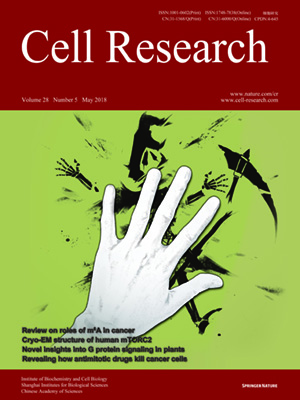
Volume 28, No 5, May 2018
ISSN: 1001-0602
EISSN: 1748-7838 2018
impact factor 17.848*
(Clarivate Analytics, 2019)
Volume 28 Issue 5, May 2018: 572-592 | Open Access
ORIGINAL ARTICLES
KRAB-type zinc-finger proteins PITA and PISA specifically regulate p53-dependent glycolysis and mitochondrial respiration
Shan Wang 1,2,3, Zhiqiang Peng 1,2, Siying Wang 4, Lihua Yang 4, Yuhan Chen 1,2, Xue Kong 4, Shanshan Song 1,2, Pei Pei 3, Chunyan Tian 1,2,Hui Yan 5, Peipei Ding 6, Weiguo Hu 6, Cui Hua Liu 7, Xin Zhang 8, Fuchu He 1,2 and Lingqiang Zhang 1,2,9
1 State Key Laboratory of Proteomics, Beijing Proteome Research Center, National Center of Protein Sciences (Beijing), Beijing Institute of Lifeomics, Beijing, China; 2 Department of Genomics and Proteomics, Beijing Institute of Radiation Medicine, Beijing, China; 3 Beijing Municipal Key Laboratory of Child Development and Nutriomics, Capital Institute of Pediatrics, Beijing, China; 4 Department of Biochemistry and Molecular Biology, Anhui Medical University, Anhui, China; 5 State Key Laboratory of Toxicology and Medical Countermeasures, Beijing Institute of Pharmacology and Toxicology, Beijing, China; 6 Fudan University Shanghai Cancer Center and Institutes of Biomedical Sciences, Collaborative Innovation Center of Cancer Medicine, Shanghai Medical College, Fudan University, Shanghai, China; 7 CAS Key Laboratory of Pathogenic Microbiology and Immunology, Institute of Microbiology, Chinese Academy of Sciences, Beijing, China; 8 State Key Laboratory of Cell Stress Biology, School of Life Sciences, Xiamen University, Fujian, China and 9 School of Life Sciences, Jiangsu Normal University, Jiangsu, China
Correspondence: Lingqiang Zhang (zhanglq@nic.bmi.ac.cn)
Few p53 regulators participate in selective control of p53-mediated cellular metabolism. How p53-mediated aerobic and glycolytic pathways are negatively regulated remains largely unclear. Here, we identified two KRAB-type zinc-finger proteins, PITA (p53 inhibitor of TIGAR activation) and PISA (p53 inhibitor of SCO2 activation), as selective regulators of p53 in metabolic control. PITA and PISA interact with p53 and specifically suppress transcription of the glycolysis regulator TIGAR and the oxidation phosphorylation regulator SCO2, respectively. Importantly, PITA transgenic mice exhibited increased 6-phosphofructokinase 1 (PFK1) activity and an elevated glycolytic rate, whereas PISA transgenic mice had decreased cytochrome c oxidase activity and reduced mitochondrial respiration. In response to glucose starvation, PITA dissociates from p53, resulting in activation of p53 and induction of TIGAR, which inhibited aerobic glycolysis. Prolonged starvation leads to PISA dissociation from p53 and induction of SCO2 and p53-promoted mitochondrial respiration. The dynamic regulation of PITA and PISA upon metabolic stress is dependent on ATM kinase-mediated phosphorylation of PITA and PISA. Furthermore, in human colorectal cancers, the elevated expression of PITA and PISA correlates with cancer progression. Depletion of PITA or PISA in colorectal cancer cells reduced the cell proliferation, migration and invasion. These results identify PITA and PISA as selective regulators of p53-mediated glycolysis and mitochondrial respiration and provide novel insights into the role of p53 network in cell metabolic control.
10.1038/s41422-018-0008-8
FULL TEXT | PDF
Browse 2233


